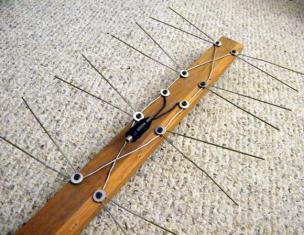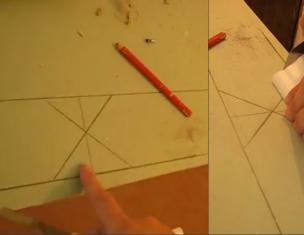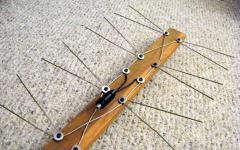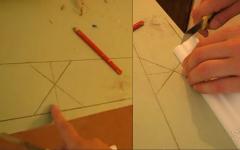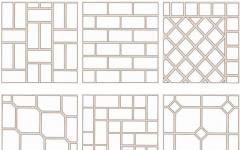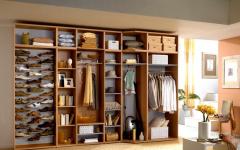When repairing repair often, the question arises, what is better - laminate or linoleum in the apartment? There is no unambiguous response, since each of the materials has several categories that differ significantly in the main operational performance. In addition, the choice is largely determined by the peculiarities of the room - attendance, humidity, the need for sanitation, the likelihood of mechanical damage, etc. There is another nuance - some properties of floor coverings depend on laying - the quality of its execution, the use of the substrate, etc.
Laminate is sometimes referred to as a natural material due to the presence in its composition of cellulose (wood) fibers, however, such a statement is not quite true, because the connective component is a polymer resin for them. In fact, the basis of the laminate is the pressed organity (more precisely - MDF or HDF), and in general, the material is performed by a multilayer - the base from two sides is covered with protective layers. From the back side, the polymer layer or kraft paper with phenolic impregnation protects mainly from moisture, and the outer (facial) surface has a multifunctional coating of acrylic or melamine resin, which partly prevents the impact of moisture (it is allowed to wipe the laminate with a wet wet rag, but with a straight hit Water coating spars) and protects against mechanical damage.
The question is that it is better to sash: laminate or linoleum is solved for a particular room, for example, for a kitchen with high humidity, the laminate will be not the best solution.
The thickness of the surface protective layer determines the strength class of the material, but even the most stable coatings it does not exceed 1 mm.
Laminate is a block flooring (unlike rolled linoleum), which is mounted from small "skies".
- The most common laminate, in which the ends of all elements are clicked latches. Laying such a coating is simplified as much as possible, although some are called a lack of cliking laminate, the presence of small gaps between blocks in which moisture can get. The obvious advantages of the laminate of this type include the possibility of creating a "floating" coating that does not have a hard clutch with the base floor over the entire surface.
- League laminates are less likely, their laying is more difficult, due to the rigid connection with the surface of the floor there may be cracks from heat deformation, if the temperature will change dramatically, but the gaps between the lamiet boards with the proper laying of impermeable moisture.
- The stripping laminate with the characteristic terrain of the end sides is most rare.
 Types of Laminate compound
Types of Laminate compound The main lack of laminate is susceptibility to moisture. Coatings of this type of any class do not tolerate water, are broken, deformed and not subject to recovery. When moisture gets into moisture, you can replace damaged items, and a cliking coating is enough to disassemble a damaged area, and the "planted" on the glue should be cut.
Laminate classes
The class of floor covering and its purpose is determined by the strength of the material and the thickness of the upper protective layer.

Appearance
Initially, the laminate was used as a floor covering, visually practically indistinguishable from a natural tree. Such models have so far become popular as attractive externally and organically combined with various interior styles. The range of the most famous manufacturers usually includes the classic and original variations of the laminate under the tree:
- natural (thin layer of varnish is practically not noticeable and the coating looks like ordinary wood),
- glossy (in such models the lacquer coating is not only noticeable, but also is a characteristic feature, the coating mimics the lacquered tree),
- matte (visually similar to a wellpring natural parquet),
- aged (the color of such a coating is darker, like a tree "with experience"),
- texture (similar to boards with coarse processing),
- waxed (warm and soft shine of boards, characteristic of wooden floors).

The technology of production of laminate allows you to create and coatings, not similar to the wooden, the most original and trendy include laminates under stone and under the skin.
Linoleum
Linoleum - rolled outdoor coating, the main advantages of which are moisture resistance and waterproofability. Such material not only easily transfers wet cleaning, including, and with the use of detergents, but also (subject to proper laying) is able to delay the water spilled or in emergency cases in small quantities. When choosing that better - laminate or linoleum, the opinion of the expert will be based on the aggregate features of the operation and characteristics of various types of materials.

Materials for manufacture
In many ways, the quality and characteristics of the linoleum are determined by its type.
- Natural linoleum is so different from other types of composition, characteristics and price, which is increasingly isolated to a separate category of flooring and is called marmoleum. On a jooty basis, the marmoleum is coated only from natural components - chalk and wood flour bound by oxidized flax oil and resins, and the drawing is performed using natural dyes. Due to the high price, marmoleum should be excluded from a comparative analysis, the purpose of which is to determine what is better, linoleum or laminate in the house.
- Nitrocellulose coatings are distinguished by plasticity and high strength with a small thickness. However, nitrocellulose linoleum is not recommended for use due to high flammability.
- Linoleum from glyftale (special variety of plastics) is produced on a tissue basis and therefore is characterized by increased heat and sound insulation. During operation, it is deformed - pulls on the width and "sitting" along the length.
- The linoleum of rubber is the most moisture-resistant and elastic, thanks to which it can easily fit on the uneven basis. At home does not apply because it has high toxicity.
- PVC Linoleum is the most common view used for commercial premises, rooms in apartments and homes, so in the future the properties and purpose of this type of floor covering will be considered. Linoleum from polyvinyl chloride can over time slightly "sit down". Such material is produced homeless or on tissue, foamed, wolp-based basis.
PVC Linoleum Production Technology
According to the method of manufacturing PVC linoleum can be homo- or heterogeneous.
- The selection of the colors of heterogeneous linoleum is significantly more due to the fact that the coating pattern is exclusively in the upper layer of multilayer material. Such a production technology removes almost all limitations regarding the choice of gamma and the complexity of the drawing. Fiberglass in the composition of heterogeneous linoleum prevents the deformation of the stretching and compression of the floor covering.
- The drawing of homogeneous linoleum is performed on the entire thickness of the coating, so that it becomes resistant to abrasion. In contrast to heterogeneous, homogeneous linoleum can be restored at a noticeable surface wear - such coatings are "grinding", removing 1/20-1 / 5 coating thickness with a homogeneous structure. The advantage of homogeneous varieties is high strength and durability. Such a linoleum is not only withstanding the steps of people, but also retains its qualities when moving carts and stocks along it. At the same time, the service life reaches 25 years or more.
When deciding that it is better to choose a laminate or linoleum in the apartment, it should be remembered that the roll material looks somewhat easier and cannot reliably imitate the tree, even if the corresponding drawing is applied to it.
Linoleum classification by appointment
The linoleum of various classes differs in strength and wear resistance, however, each category has other nuances.
- The cheapest linoleum is household. It is most often a multilayer material from the foamed PVC, a decorative layer and a protective coating. In sum, the thickness of all layers usually does not exceed 4 mm. The coating has a soft base and serves not for a very long time even with a gentle operation mode.
- Semi-commercial type of coating can be called an improved version of the household linoleum. It is more durable and has a greater thickness - from 0.7 cm. The structure of such coatings is practically no different from the household roller material.
- Commercial linoleum is designed for significant loads and is characterized by maximum wear resistance. Due to the fact that this line of linoleum is often used for premises with high attendance, the surface may have an additional anti-slip coating.
- Specialized, manufacturing special requirements defined by nuances of exploitation:
- sports with polyurethane coating,
- for medical institutions with bactericidal components in the surface layer,
- with enhanced sound insulation for musical studios, relaxation rooms, etc.,
- With relief on the surface, which prevents slip, even when water gets into linoleum. 
Comparison of materials according to the main parameters
What is better to lay on the floor - laminate or linoleum, solve taking into account the requirements for a concrete room. The choice will help comparing floor coatings on the most significant parameters.
Insulation qualities
The heat and sound insulation properties of the coatings of both species are determined in most cases the characteristics of the substrate. That warmer - laminate or linoleum - largely depends on its material and thickness. It is important to remember that the substrate is an add-on for linoleum, the use of which depends on the desire of the premises owner, and for laminate it is a mandatory element when laying the coating. Among the various varieties of linoleum are the warmest are those that have a dense tissue or felt basis.

Linoleum due to its plasticity better absorbs sounds, especially this applies to the material with a soft basis, while walking on laminate in shoes with a rigid sole or heels can be heard throughout the apartment. But here again, a high-quality substrate comes to the rescue of Laminate, which serves as an excellent sound insulator. 
Ecology
What is environmentally friendly - laminate or linoleum? Both coatings (taking into account the fact that, from the entire variety of linoleum variants, PVC material is chosen) do not emit toxic substances during operation. When comparing ecology often mention the complexity of the utilization of linoleum, which is lit with the formation of a sharp smell and the release of harmful substances. However, given that independently dispose of the removed coverage of household owners and apartments has to be extremely rare, this lack is not the most significant.
Transportation
Transportation of packed in the compact blocks of laminate skids is much simpler - they can be transported in a personal car and raise the floor in the elevator. Rolls of linoleum have large dimensions (the width of the roll can reach 5 m) and weigh a lot, so for their delivery to the object, freight transport may be required, and in the usual passenger elevator such a roll can not fit.
Laying and repair
Laying the linoleum and laminate is quite simple and to obtain high quality coverage to the home master, the instructions are fairly accurately, but still the laminate floor assembly requires a more responsible approach. The laying out of the roll material requires less time compared to the assembly of the coating of the sheet, although this will require the use of adhesive composition or bilateral tape. 
At the same time, for the flooring device from laminate, the floor should be as even as possible, in connection with which it may be required to align it with special building mixtures.
Laminate is more maintainable material, if necessary, such a floor can be partially disassembled and some of the boards are replaced with new ones. Also, small chips and cracks on the panels are perfectly close using special repair pastes. Lenoleum is thus repaired not to succeed and it will come to change the entirely, and it is more inclined to get scratches and other similar damage.
Moisture resistance
One of the most significant differences in the coatings - the laminate is poorly tolerated humidity, and the linoleum does not change its qualities even when a large amount of water gets. Although it should be noted here that there are moisture-resistant models of laminate.
Appearance and features of operation
Despite the new technologies, the rolled material looks not so presentable and can not reliably imitate natural wood, although the imitation of other materials linoleum is very good.
Speaking about the features of use, it should be noted that heavy furniture and heels can leave traces on the linoleum, while the laminate is more durable in this regard material.
Laminate care must exclude floor washing with a wet rag (you can use a well-pressed wet cloth or mops), while there is no such restrictions for the lenoleum.
Taking into account all the advantages and disadvantages, it is most often recommended at home Linoleum to choose for rooms where water can get to the coating, besides, excessive humidity may be present in the air - bathrooms, kitchens, balconies. The hallway has often to wash. Therefore, the choice of linoleum will also be successful here. Laying of linoleum in the pantry is justified by the economy and simplicity of installation of the coating.
In children's rooms, canteens, living rooms, bedrooms laminate will look great and will retain their durability.
And finally, speaking about the cost, we note that when choosing between the laminate and the linoleum of the average price category, the price wins linoluy and the price difference may differ twice.
Opinions of the experts on Lamitate and Linoleum can also be found from the video.
Tweet
Plus



